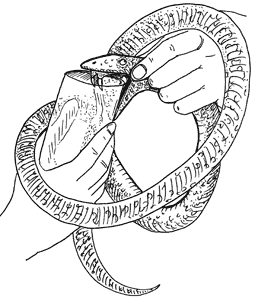STRANGE BUT TRUE- Reptile riches: Snake venom better than gold

DRAWING BY DEBORAH DERR McCLINTOCK
Q. What's the trick to "milking" a venonous snake? –Eve
A. Experts grasp the head and hook the fangs over the edge of a collecting vessel, says Marty Crump in Headless Males (Mantids) Make Great Lovers. After a few angry squirts, the venom is frozen and vacuum dried, then injected into horses or sheep in small doses until the animal achieves immunity.
Next, blood is drawn, and the serum containing the antibodies is purified. Venom extraction facilities operate around the world to provide antidotes for snakebite victims. And more: current research suggests that someday snake venom may be used to destroy certain types of tumors, treat osteoporosis, lower blood pressure, promote blood clotting, and reduce pain.
In rural India, the tribal Irula people had long earned a living by catching snakes, with the skins exported to become luxury belts, shoes, handbags. But when the government banned this, the Irula formed a cooperative for venom extraction. Cobras, vipers, and kraits are now milked three times before being returned to the wild. Fortunately, venom from kraits pays 10 times what the skins did.
"Worth 5 to 1,000 times as much as gold by weight, snake venom is one of the world's most valuable natural resources," says Crump.
Q. Why is it so tough to remember people's names? –E. Kraepelin
A. We pay insufficient attention as we are introduced, so we only half-hear the name and usually find no reason to repeat it in the initial conversation, say Miles Hewstone, Frank Fincham and Jonathan Foster in Psychology. Also, names are generally perceived as meaningless, conjuring up few mental pictures.
And the problem may go even deeper, involving a sort of mental block: When researchers showed subjects photos of faces and presented words like "Cook, Carpenter, Porter" as either the person's name or occupation, recall was better for the words presented as occupations. "It is apparently easier to learn that someone is a carpenter than that they are named Mr. Carpenter," the authors say.
There are mnemonic devices– meet a "Gordon" and picture his face with a "garden" growing on it–but these seem to work only in lab settings. Best bet is to test yourself 30 seconds after being introduced, then a minute later, and so on. Used in conjunction with meaningful associations, this can be effective.
Thus the column authors– with a name like Sones, meaning a unit of sound– might be better remembered at a scientific seminar than at a journalists' convention.
Q. A polygamous king in a polygamous land worried that boys/girls seemed born in equal numbers, making it impossible for every man to have several wives. So he issued a decree that families had to stop having children once the first boy was born. This way, no family would have more than one boy, but many could have multiple girls. Yet later the king was shocked when a census showed his decree had no effect whatsoever. What was going wrong? –E. Sanger
A. Assume under the decree all families have as many children as possible. Now while it's true every family will have one boy, half of all families– those producing a boy first– will have no girls, points out Raymond Nickerson in Cognition and Chance. Only half will have one or more girls, one-fourth will have two or more girls, one-eighth three or more girls, etc. When you add all these up, the numbers of girls and boys turns out to be about the same.
An analogy: Imagine the above as sequences of coin tosses, where heads (H) signifies a boy. Then you get H (1/2 of all sequences), TH (1/4), TTH (1/8), TTTH (1/16) etc. Although many sequences have several Ts, none has more than one H. Still, the total number of Hs and Ts in all the sequences combined will be about equal. "This is intuitively obvious since with any large number of tosses of a coin, heads and tails should come out about the same."
Sorry, king, it was your math that was wrong!
Q. Who rules the Earth, humans or bugs? -B. Bunny
A. Before answering, consider that insects have been around some 400 million years to Homo sapiens' 300,000, three-quarters of all known animal species are insects, for every type of insect so far discovered there are from three to 30 still unknown, and for every person on Earth there are about 500 tons of bugs, says May Berenbaum in Bugs in the System: Insects and Their Impact on Human Affairs.
Through pollinations, blights, plagues, and spreading disease among soldiers during war, bugs have altered history more than just a mite.
Send Strange questions to brothers Bill and Rich at [email protected].